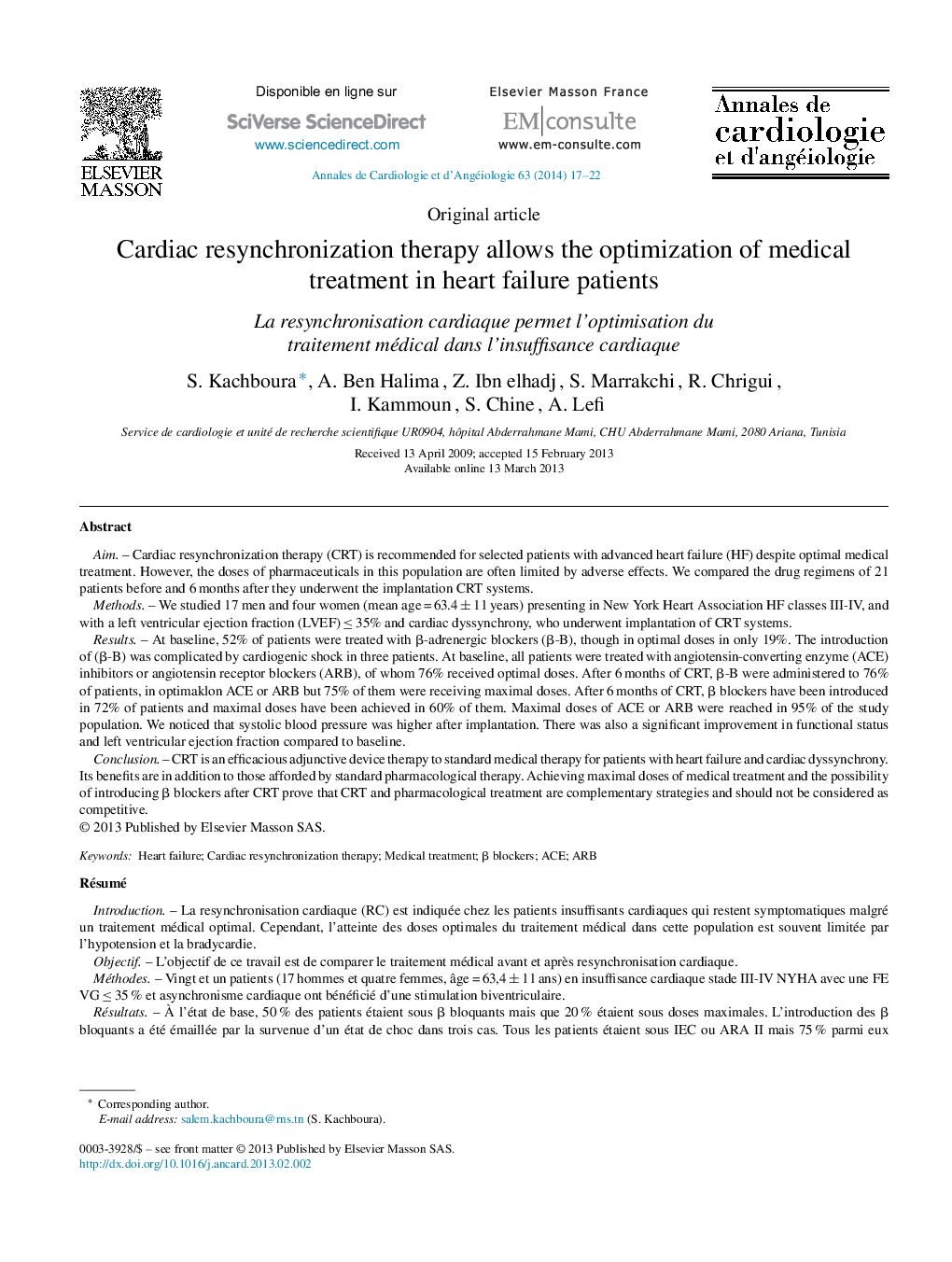| Article ID | Journal | Published Year | Pages | File Type |
|---|---|---|---|---|
| 2868751 | Annales de Cardiologie et d'Angéiologie | 2014 | 6 Pages |
AimCardiac resynchronization therapy (CRT) is recommended for selected patients with advanced heart failure (HF) despite optimal medical treatment. However, the doses of pharmaceuticals in this population are often limited by adverse effects. We compared the drug regimens of 21 patients before and 6 months after they underwent the implantation CRT systems.MethodsWe studied 17 men and four women (mean age = 63.4 ± 11 years) presenting in New York Heart Association HF classes III-IV, and with a left ventricular ejection fraction (LVEF) ≤ 35% and cardiac dyssynchrony, who underwent implantation of CRT systems.ResultsAt baseline, 52% of patients were treated with β-adrenergic blockers (β-B), though in optimal doses in only 19%. The introduction of (β-B) was complicated by cardiogenic shock in three patients. At baseline, all patients were treated with angiotensin-converting enzyme (ACE) inhibitors or angiotensin receptor blockers (ARB), of whom 76% received optimal doses. After 6 months of CRT, β-B were administered to 76% of patients, in optimaklon ACE or ARB but 75% of them were receiving maximal doses. After 6 months of CRT, β blockers have been introduced in 72% of patients and maximal doses have been achieved in 60% of them. Maximal doses of ACE or ARB were reached in 95% of the study population. We noticed that systolic blood pressure was higher after implantation. There was also a significant improvement in functional status and left ventricular ejection fraction compared to baseline.ConclusionCRT is an efficacious adjunctive device therapy to standard medical therapy for patients with heart failure and cardiac dyssynchrony. Its benefits are in addition to those afforded by standard pharmacological therapy. Achieving maximal doses of medical treatment and the possibility of introducing β blockers after CRT prove that CRT and pharmacological treatment are complementary strategies and should not be considered as competitive.
RésuméIntroductionLa resynchronisation cardiaque (RC) est indiquée chez les patients insuffisants cardiaques qui restent symptomatiques malgré un traitement médical optimal. Cependant, l’atteinte des doses optimales du traitement médical dans cette population est souvent limitée par l’hypotension et la bradycardie.ObjectifL’objectif de ce travail est de comparer le traitement médical avant et après resynchronisation cardiaque.MéthodesVingt et un patients (17 hommes et quatre femmes, âge = 63,4 ± 11 ans) en insuffisance cardiaque stade III-IV NYHA avec une FE VG ≤ 35 % et asynchronisme cardiaque ont bénéficié d’une stimulation biventriculaire.RésultatsÀ l’état de base, 50 % des patients étaient sous β bloquants mais que 20 % étaient sous doses maximales. L’introduction des β bloquants a été émaillée par la survenue d’un état de choc dans trois cas. Tous les patients étaient sous IEC ou ARA II mais 75 % parmi eux recevaient un traitement maximal. Après six mois de RC, les β bloquants ont pu être introduits chez 72 % des patients et des doses maximales ont été atteintes dans 60 % des cas. Des doses maximales d’IEC et d’ARA II ont été atteintes chez 95 % de la population. On a remarqué que la pression artérielle systolique était plus élevée après l’implantation. On a noté également une amélioration du statut fonctionnel et de la FE VG par rapport à l’état de base.ConclusionLa RC est un traitement adjuvant efficace au traitement médical standard chez les insuffisants cardiaques dysynchronisés. Ces bénéfices sont supplémentaires à ceux qui sont obtenus par le traitement médical standard. L’atteinte de doses maximales de traitement médical et la possibilité d’introduire les β bloquants après RC démontrent que la RC et le traitement pharmacologique sont des stratégies complémentaires et ne devraient pas être considérées comme compétitives.
